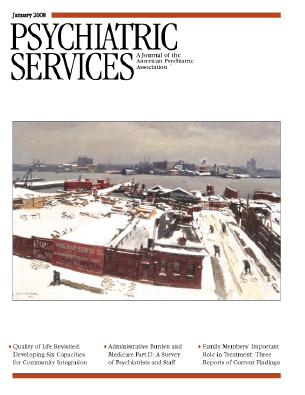Predictors of Enduring PTSD After an Industrial Disaster
To the Editor: Only a few studies have examined the long-term effects (more than one year) of mass trauma on victimized communities (
1,
2 ). On September 21, 2001, a petrochemical plant exploded in the city of Toulouse, France. Victims were surveyed by using self-report questionnaires that assessed peritraumatic distress and dissociation and acute stress. A hierarchical multiple regression conducted with survey data gathered six months after the explosion indicated that all three constructs explained unique variance, accounting for 62% of the variance in symptoms of posttraumatic stress disorder (PTSD) (
3 ). Here we report the results of a follow-up survey conducted 15 months after the explosion. The survey used the same predictors plus a measure of depression.
Five to ten weeks after the explosion, 892 potential study participants were sent self-report questionnaires to assess symptoms of acute stress (Stanford Acute Stress Reaction Questionnaire) and depression (Beck Depression Inventory). The 391 persons who responded were sent another self-report questionnaire six months after the explosion. The second survey retrospectively assessed peritraumatic dissociation (Peritraumatic Dissociative Experiences Questionnaire) and distress (Peritraumatic Distress Inventory) as well as current PTSD symptoms (Posttraumatic Stress Disorder Checklist). Fifteen months after the explosion, the 200 participants who responded to the second survey were sent the same questionnaire assessing PTSD symptoms, and 129 persons responded to this third survey.
To analyze the relationship between predictors and PTSD symptoms at 15 months, we computed Pearson correlations. Strong correlations with PTSD symptoms were found for peritraumatic dissociation (r=.50, p<.01), peritraumatic distress (r=.58, p<.01), acute stress symptoms (r=.71, p<.01), and depression symptoms (r=.61, p<.01). We computed a hierarchical multiple linear regression with PTSD symptom score as the dependent variable. Peritraumatic dissociation was entered first, followed by peritraumatic distress in the second step, symptoms of acute stress in the third step, and symptoms of depression in the fourth step. The model accounted for 59% of the variance in PTSD symptoms. All of our predictors were strongly correlated with persistent PTSD symptoms 15 months after exposure.
The number of dropouts and retrospective ratings of the peritraumatic responses should be acknowledged as potentially limiting the generalizability of these results. However, the study found that peritraumatic dissociation and distress, acute stress, and depression were related to the development and persistence of PTSD symptoms after an industrial disaster. Loss of control and helplessness-anger, measured with the Peritraumatic Distress Inventory, were strong predictors of posttraumatic stress one year after the World Trade Center disaster (
4 ).

